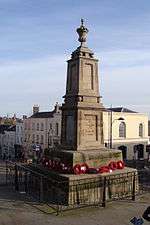Eric Francis (architect)
| Eric Carwardine Francis | |
|---|---|
| Born |
30 August 1887 Chepstow, Monmouthshire, Wales |
| Died |
26 January 1976 West Monkton, Somerset, England |
| Nationality | British |
| Occupation | Architect |
Eric Carwardine Francis (30 August 1887 – 26 January 1976)[1] was a British architect and painter who designed a number of notable buildings, particularly in Monmouthshire, Gloucestershire and Somerset, in the early and mid-twentieth century, many in the Arts and Crafts style.
Life and career

He was the son of George Carwardine Francis, a solicitor of Chepstow. He was articled in 1909 as an architect under Sir Guy Dawber, before becoming an assistant to another leading member of the profession, Detmar Blow.
He then began working with the writer and architectural historian Henry Avray Tipping, who, after inheriting a family fortune, bought land in 1911 at Mounton near Chepstow on which to build a new home. While Tipping described himself as the designer of Mounton House, Francis was responsible for its details and materials.[2] He also worked with Tipping in designing houses on the new Rhiwbina housing estate in Cardiff.[3]
Francis then designed the "unusual, neo-Baroque"[4] War Memorial in Beaufort Square at Chepstow, unveiled in January 1922, before working for another private client in the area, Charles Clay, of the family that owned the nearby Piercefield estate. Francis designed Wyndcliffe Court at St Arvans, a large private house completed for Clay in 1922 and described as being in the "Cotswold Tudor style, relaxed and sophisticated".[5] In 1922/23 he undertook work at Chepstow Castle for its owner, W. R. Lysaght, including refacing some of the walls in red sandstone.[6] He also worked again with Avray Tipping, designing and constructing with him Tipping's retirement home, High Glanau near Trellech. The house is built in the Arts and Crafts style, set above formal gardens.[7] In 1925, Francis designed and built his own house, East Cliff, situated above the River Wye at Tutshill near Chepstow.[8]

In 1926 Francis married Lady Elizabeth Annesley, a cousin of Earl Annesley.[9] Thereafter, he moved to Somerset, and joined H.S.W. Stone in the Taunton architectural practice of Stone and Lloyd, later known as Stone and Partners.[10][11] Among the houses he built in Somerset was his own house, Long Meadow at West Monkton, started in 1929.[3] He was later responsible for much restoration work, and for the design of the Catholic Church of St Teresa of Lisieux in Taunton,[10] opened in 1959 and described as "an airy, light and beautiful Church, fitting happily into the modern housing around it".[12]
Francis was also an accomplished hockey player, participating in the Wales international game against Ireland in 1920.[3] He became a Fellow of the Royal Institute of British Architects in 1923. He was also a member of the Society of Antiquaries.[10] He died in West Monkton, Somerset, in 1976 at the age of 88.
References
- ↑ Eric Carwardine Francis at the archINFORM database. Retrieved 24 April 2012.
- ↑ Newman, John (2000). The Buildings of Wales: Gwent/Monmouthshire. Penguin Books. pp. 67–68. ISBN 0-14-071053-1.
- 1 2 3 Gerrish, Helena (2011). Edwardian Country Life: The Story of H. Avray Tipping. Frances Lincoln Ltd. pp. 101, 126. ISBN 978-0-7112-3223-5.
- ↑ Newman, p.187
- ↑ Newman, p.520
- ↑ Rick Turner and Andy Johnson (eds.), Chepstow Castle - its history and buildings, 2006, p.265, ISBN 1-904396-52-6
- ↑ Newman, p.208
- ↑ David Verey, Alan Brooks, The Buildings of England: Gloucestershire: The Vale and the Forest of Dean, Yale University Press, 2002, ISBN 0300097336, p.121
- ↑ Earldom of Annesley. Accessed 24 April 2012
- 1 2 3 RIBA Journal, vol.83, 1976
- ↑ Stone & Partners, Taunton. Accessed 25 April 2012
- ↑ Taunton Catholic Church: St. Teresa of Lisieux